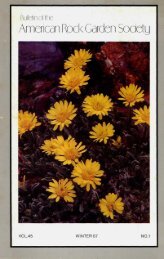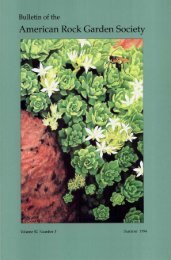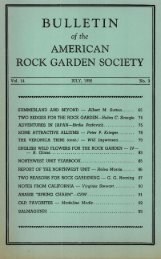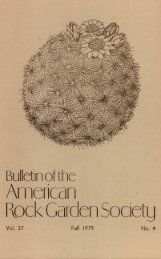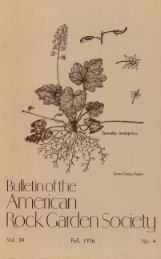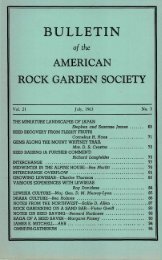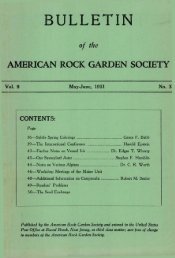Bulletin - Summer 1979 - North American Rock Garden Society
Bulletin - Summer 1979 - North American Rock Garden Society
Bulletin - Summer 1979 - North American Rock Garden Society
You also want an ePaper? Increase the reach of your titles
YUMPU automatically turns print PDFs into web optimized ePapers that Google loves.
den gave me three plants, among thema Geranium sanguineum lancastrienseor true geranium and I was caught.It came as a shock to me that thegeranium of my childhood, the flowerthat was sold by all florists and whichadorned the window-sills of many aschoolroom, was not a geranium atall. Then Mrs. Briggs, a rock gardenexpert, gave me about thirty alpineand saxatile plants and I was boundhand and foot, imprisoned, corralled,encysted, incased.It so happens that at one side ofour lawn there is a slight slope. ThisI have converted into what is calleda scree, that is, "a mass of detritus,forming a precipitous, stony slope upona mountain-side". There is nomountain-side, and there is nothing precipitousabout it; but I did turn thesoil, added well-rotted compost, brokenstones and chicken grit and introducedlarger rocks, buried, like icebergs, eightninethsbelow the surface. At the sametime I tried to give the garden a naturallook. A local farmer permitted me toraid his stone pile which I did frequently,accompanied by groans fromthe car; the smaller stones I gatheredat the lake shore and these were usedprimarily as mulch. To provide betterdrainage (the sine qua non of rockgardening) I built two short dry wallsin the interstices of which I plantedseveral varieties of campanula.At first, the garden measured fourby fifteen feet; as plants were given me(rock gardeners are indeed generous) thegarden was extended fifteen feet; aftertwo years, the garden now measures fourby forty-five feet, a modest garden to besure, but a rock garden and not a gardenof rocks. There are about sixty differentplants.Of course, I couldn't do withoutguides, the most useful being H. LincolnFoster's <strong>Rock</strong> <strong>Garden</strong>ing, charminglyillustrated by Laura Louise Foster. Ijoined the <strong>American</strong> <strong>Rock</strong> <strong>Garden</strong> <strong>Society</strong>which can boast a membershipmore exclusive than either the Quakersor the Mafia, and receive the helpfulARGS <strong>Bulletin</strong> four times a year. Ibought seeds from the ARGS Seed Exchange;and I began to meetknowledgeable and dedicated rock gardeners.Well, here are no gorgeous, sophisticateddisplays; there are nodahlias, no fireballs, no peonies gotup like over-dressed and bejewelleddowagers; no super-giant parrot tulips,no giant hyacinths, in fact, no giantanything. Everything is on a smallscale. To see some of the flowers Ihave to get down on my hands andknees but it is worth the effort.Simplicity and delicacy — these arethe dominant qualities one finds in arock garden. There is nothing grossabout any alpine or saxatile plant.Every day in spring, summer andfall I attend the garden. There is wateringto be done, weeds to be pulled,the more aggressive species to berestrained, the more fragile to be protected.Often I just stand and admireand note developments. On dour winterevenings I plan ahead. This comingyear I hope to begin growing fromseed since, as Foster says, "plants ofthe rarer alpines are almost impossibleto obtain from nurseries". And thisneophyte likes to experiment.Sermons in rock gardens? Ofcourse, there are sermons in rock gardens,sermons that one hears from allnature, from the mountains, the fields,the oceans and the streams, from thesmallest of animals and the most insignificantof flowers, and all basedupon the same text: ignore nature atyour peril.I like, however, to think that myplants have a special message. They149



